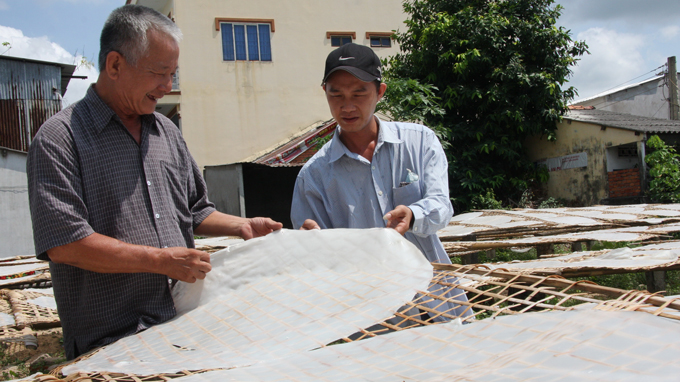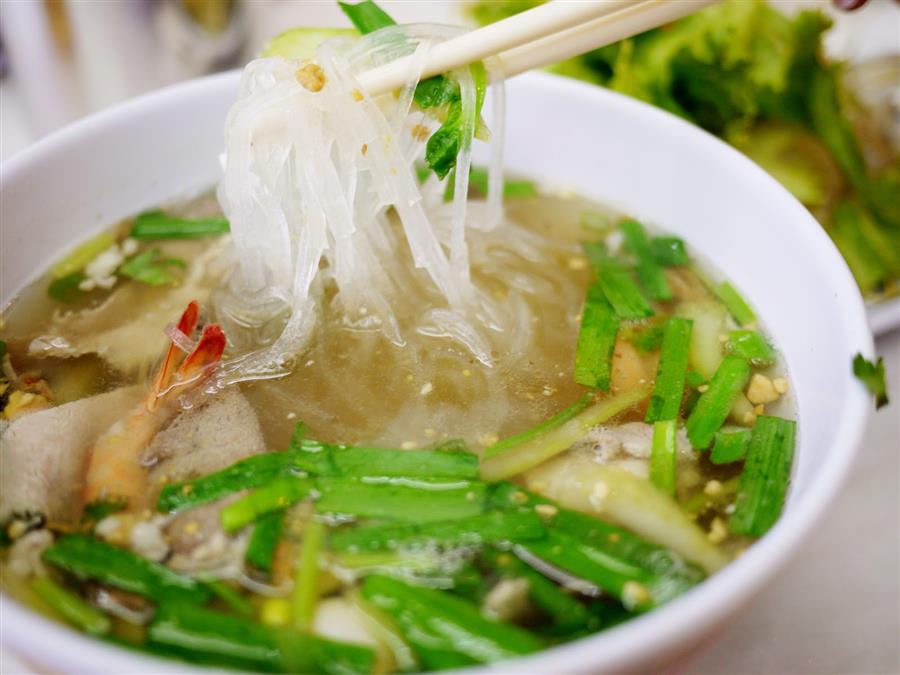
Mr. Huynh Tai Phuc (left) checks the moisture of the noodles before cutting them into strands - Photo: V.Tr.
In recent years, domestic and international tourists coming to My Tho City (Tien Giang) want to enjoy this famous delicacy.
A lot of work
My Tho noodle village
Mr. Truong Van Thuan, head of the My Tho Hu Tieu Village Cooperative in My Phong Commune, said that his cooperative has 10 facilities producing Hu Tieu, mainly using machines, not by hand. Every day, the craft village supplies 6-7 tons of Hu Tieu noodles to the markets of Tien Giang, Long An, and Ho Chi Minh City. Because Hu Tieu noodles can only be preserved for two or three days, they can only be transported short distances, not long distances. The large amount of noodles consumed is because these facilities sell to both Hu Tieu and Pho shops. Most people in the South like to eat Pho cooked with Hu Tieu noodles, while few people eat fresh Pho noodles like in the North.
One of the oldest handmade noodle makers in My Tho City, Mr. Huynh Tai Phuc (64 years old) said that when he was born, his parents made noodles at home. Mr. Phuc's family has been making noodles for over 70 years, and is now passing the tradition to the third generation, his children. My Tho people still call this the Chin Xe noodle factory. At Mr. Phuc's house, there is a handmade noodle production factory (except for the steps of grinding flour and cutting rice paper into noodles, which are done by machine) that was built decades ago. It is a rice husk furnace built with bricks, four molds for spreading flour and steaming it before drying, and hundreds of bamboo trays for drying rice paper. Mr. Phuc's children directly make noodles and deliver them to noodle shops and pho shops from 4am to 4pm every day, without hiring any workers.
“In the past, my parents made noodles the same way, and now my children and I do the same. The only difference is that in the past, rice paper was cut into noodles with a knife, but now it is cut by machine, which is faster, the noodles are smaller and more even,” said Mr. Phuc. When asked why he did not produce noodles by machine like other places, Mr. Phuc said that My Tho noodles were famous in the past because they were made by hand, with their own secrets, and if made by machine, they would not be as delicious. “It is not that I do not have the capital to invest in machines, but I still do it by hand because I want to preserve the so-called essence of My Tho noodles for people to enjoy,” Mr. Phuc affirmed.
According to Mr. Phuc, the reason why My Tho noodles are famous throughout Asia is because the noodles are made from rice flour, not mixed with wheat flour or tapioca flour; the noodles are clear, chewy, not salty, not sour, and have the aroma of rice. In addition, the broth must be delicious. When the broth is poured into the bowl, the noodles expand, the water soaks in but the noodles are still chewy, then it is delicious. "If the water comes out, the noodles come out, or the noodles fall apart when meeting the broth, have a salty or sour taste, it is considered a failure" - Mr. Phuc said. Many famous noodle shops in My Tho such as Quan Ky (Ngo Quyen), Pho Dong Thanh (Ly Thuong Kiet)... said that the noodles produced by Chin Xe oven always meet the criteria of "clear, naturally chewy, fragrant, not sour, not salty".
To produce delicious noodles, the first step is to choose good rice, which according to Mr. Phuc, is the type of rice that has a lot of starch, the rice cooks well but the rice is hard. In addition, the step of spreading flour on the mold is the most important, deciding whether the batch of noodles is chewy and clear or not. Rice flour should not be mixed with any other type of flour to help the noodles chewy, but must be adjusted with fire. The temperature of the oven when spreading flour on the mold to steam must reach 120OC or higher. If the temperature is too low, the rice paper will not be chewy, the noodles will be cloudy and it is considered a failure. When the rice paper is steamed, roll it up in a bamboo tube, then spread it on a bamboo tray and dry it in the sun for about three hours. Then remove the rice paper, put it in a noodle cutting machine and it is done.
Delicious thanks to the secret of cooking broth

In My Tho City today, there are hundreds of noodle shops, but the people of this city will find it difficult to answer the question: "Which shop sells delicious My Tho noodles like in the old days?". Those who have been making noodles for a long time and even the elders here all say that there are only 1-2 noodle shops that have kept the essence of the noodle broth that was passed down from previous generations. Among them is Quan Ky restaurant on Ngo Quyen Street, Ward 1. This noodle shop has existed for more than 50 years and is very famous in the South. Many travel companies in Ho Chi Minh City bring tourists here to enjoy My Tho specialties.
A senior in the noodle making profession in My Tho said that when a provincial tourism company put up a My Tho noodle sign, but when they tried it, they were not impressed. The broth was bland, the noodles had been boiled in water and left in the bowl for a long time, so they had expanded and then woven into a ball. That was not the My Tho noodle of the past.
Ms. Dang My Huong (49 years old), the fourth generation "successor" of Quan Ky noodle shop, also affirmed that in addition to fragrant, clear, naturally chewy noodles, My Tho noodles are highly appreciated by many diners thanks to the broth. "For over 50 years, my family has cooked broth following a recipe passed down from our ancestors. Good broth must be simmered with bones for 2-3 hours, accompanied by meat, pork intestines, dried shrimp, and dried squid. After simmering, the broth will have the color of meat, bones, and marrow that dissolve into the broth. If the broth is too clear, it will not be delicious because there are not enough bones and meat," Ms. Huong said.
According to Ms. Huong, the broth is sweet thanks to the bones and meat, not sugar or MSG, so these spices should not be overused. “Every day I use more than 20kg of bones to make enough sweet broth. During the bone-simmering process, I have to constantly skim off the foam so that the broth is clear. This amount of broth is only used for more than 100 bowls of noodles. If you overuse sugar and MSG, you will have a burning sensation in your throat and customers will react immediately,” Ms. Huong said.
Preserving the essence of My Tho noodle specialty
Mr. Nguyen Ngoc Minh, Director of the Department of Culture, Sports and Tourism of Tien Giang, said: “Although My Tho noodles have been famous for a long time, the fact that My Tho noodles have been recognized as a new Asian delicacy is good news for the locality. Therefore, the Department of Culture, Sports and Tourism of Tien Giang will organize events to inform and promote this honor to everyone so that together they can appreciate, preserve and promote the values of this specialty. The Department will also have plans to organize training courses, impart experiences in making noodles and preparing a delicious bowl of noodles to serve local people and domestic and international tourists.”


































